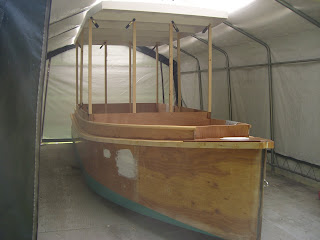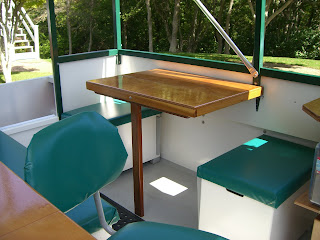
Why Build Another Boat? How "Grinder" Happened.

I Don't Really Know Why
.JPG)

and liked the SkiffAmerica, and agreed with Adams on most of his design goals:
"1. Classic style ("head turning" appearance) 2. Modern leakproof construction (epoxy, taped seam) 3. Easily built using quality materials 4. Durable 5. Low maintenance 6. Affordable 7. Trailerable 8. Easily launched from trailer 9. Shoal Draft 10. Beachable 11. Planing hull 12. Efficient 13. Long Range 14. Good load carrying ability 15. Generous storage capacity 16. Sea kindly and safe hull design 17. Smooth riding 18. Great handling and maneuverability 19. Cruising for two or day trips for two families 20. Comfortable accommodations"
At the top of my personal list would be serenity. "Bantam" was very quiet, and the new boat should be too.




Figuring It Out and Building
Bolger later modified the design to have a small sitting height cabin with a sliding roof, and called it the "Cabin Clam Skiff".
I wanted standing head room, a little more cabin space, and a swim platform/motorboard. I liked that the hull was square sided, and I could make my cabin ends the bulkhead structural members. If I made the chines triangular, I could glass them, and have a very smooth interior.
Water that came aboard could drain right through limber holes on the sides of the bulkheads, through the cabin, and back to a bilge pump.
The boat is flat bottomed, with a little rocker at the bow. It has a huge 16" wide by 1 1/2" deep shoe, which Bolger said came from his experiments with "cutwaters". How will the hull perform? I don't know, but from what I've read, if you just slow down a flat bottom boat when the water is rough, you'll be ok. I want a canal cruiser that can jump up and run if the water is flat, and for some reason I want to get the fun over with in a hurry. I think the big shoe, and the 1" thick hull, will make pounding less of a bother, but...
Here's photo of the hull sides joined with " Payson Joints", and the bulkhead locating battens glued on. If you get to this stage, you pretty much have a boat.

The two cabin end/bulkhead are cut a little long, attached to the floor and stern and motorboard go in. All the fastening was done with sheet rock screws into the battens. After the epoxy set the screws were removed, holes filled and seams taped.
.

Building....



So far, so good. The basic hull of the skiff builds in a hurry.
The roof of "Bantam" had to be redone because the foam/thin ply/glass sandwich was too heavy. Very stiff, but too much weight. I tried to make the roof of the Cabin Skiff as light as I could, while still using wood, not fabric. I crowned it slightly to make it stiffer. It weighs 48 lbs. without the grab rails or paint, more like a kind of wood bimini. The edges slightly overlap the cabin on the sides, and extend 6'' in the stern, and 2' at the bow.
Making a Convertible

Mocking up the Cabin and Top
 The posts bolt to the cabin sides and to the roof. The whole arrangement can be taken apart and lowered if the boat is going to trailer any real distance. Probably a few hours work taking down and setting up.
The posts bolt to the cabin sides and to the roof. The whole arrangement can be taken apart and lowered if the boat is going to trailer any real distance. Probably a few hours work taking down and setting up.I don't want to trailer the boat at high speed with the roof up for fear of wind damage.
Eureka Moment
When I figured it out, and did the first rough install, pleased is too faint a word. Here is the first part of the solution. The table lowers and fits on cleats on the bins, and becomes part of the jig saw puzzle that makes up the base for the mattress.
.JPG)
Cabin/Helm
I made very lightweight seating/storage bins from eighth inch okume and the quarter inch plywood packing crate that the okume came in. They can be moved around, and even stacked, to change the cabin layout.
The galley has a shelf that makes the final extension of the base for the mattress. So, on the port side, the two 16"x24" seats, the 24"x32" table, and the galley shelf all work as the mattress base. On the starboard side, another identical 16"x24" bin, and one 16"x50".
The starboard bins "L" to give more helm room.
To set the cabin up for sleeping, the table top lowers to the cleats on the two seats, and the starboard bins slide over next to the other furniture.
There is enough room, even when the bed is set up, to make some coffee, get underway and steer, or to go forward to the bow. Getting out the back door means stepping over the edge of the mattress.
An "Origami" folding tender and oars fit under the shelf/ seat you can see on the port side of the bow. How cool is that?
The engine, controls, instruments etc. will go in this Spring. Hard to wait.
"Grinder" First Impressions
.JPG)
The engine is one of the new fuel injected Honda 40 HP four strokes. The prop is an 11" by 13" pitch 3 blade.
The testing so far shows a hull speed of 5.8 knots at 2200 rpm, then the boat gets up on plane at around 3500 and 11 knots. Both these speeds are pleasant cuising speeds, with little noise and good fuel economy. WOT speed is 21 knots, but that is much too fast to be enjoyable.
There was an initial problem with spray. The water hit between the fenders and was thrown into the cabin. I bridged the first few fenders with fender plastic, and added spray rail of indoor-outdoor carpet at the bow. Very little spray comes aboard now under most weather conditions.
Here's video of a high speed pass.
My wife and I slept aboard soon after we put it in the water. The cabin arrangements worked even better than I had hoped, with the exception of the inflatable mattress. It worked, but I found that 2 self inflating camp pads work better, and one of the pads can be used for napping on the bench/storage boxes.
I'll post more about the interior later.
Another Beauty Shot
When it is moored, the galley and helm are covered with vinyl. The bilge pump works very well. If it has rained, we stand on the stern and the pump goes on and takes out most all the remaining water.
And here's another video of a pass.
You don't want to go this fast in choppy water, but it's fun to let it rip occasionally.
Cabin Set Up


Hudson River Trip Glitch

Here's a photo of the tow truck about to load our truck and trailer after the transmission failed on I-90, halfway to our destination.
The new plan is the Rideau Canal in June, and a new truck.










